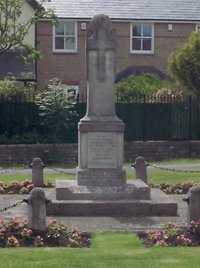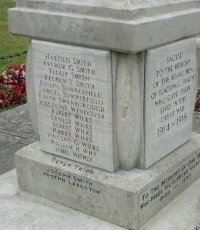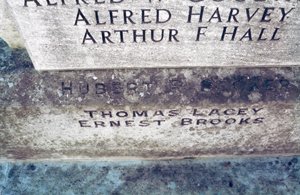Showcase result
Flackwell Heath
Town or City: Flackwell Heath
County: Buckinghamshire
Country: England
WMT Reference Number: WM2319
Value of grant: £535.00
Type of memorial: Freestanding
Type of work: Conservation and repair
Grant scheme: Small Grants Scheme
Year: 2008
UKNIWM reference number: 8306
 Flackwell Heath war memorial obelisk stands on a grassed area at the junction of Common Road and Treadway Road in the village. The memorial is within a conservation area. The Portland Stone obelisk stands on a three stepped base and is surmounted with a ball. The four sides have reliefs of crosses and the entire memorial is surrounded with a chain fence.
Flackwell Heath war memorial obelisk stands on a grassed area at the junction of Common Road and Treadway Road in the village. The memorial is within a conservation area. The Portland Stone obelisk stands on a three stepped base and is surmounted with a ball. The four sides have reliefs of crosses and the entire memorial is surrounded with a chain fence.
In 2008 War Memorials Trust provided a grant of £535 towards conservation work. This included repointing the memorial, plinth, and surrounding paving; re-painting of some of the lettering and cleaning with low pressure water and bristle brushes.
The memorial was built by H. T. Dickens and the architect was Mr T. Thurlow. It was unveiled on 8th May 1921 by the Lord Lieutenant of Buckingham, Sir Charles Robert Wynn-Carington, 1st Marquess of Lincolnshire whose son, Viscount Wendover is recorded on the memorial.
World War I casualties recorded on the memorial include:
 William Rogers
William Rogers
Albert Sarney
Charles Saunders
Albert Stallwood
Harold Smith
Arthur G Smith
Reuben T Smith
Joseph Summerfield
Samuel Summerfield
Ralph Swanborough
Viscount Wendover
Albert Wilks
Ernest Wilks
Albert Wilks
Harry Wilks
Vincent G Wilks
William H Why

Albert Edward Charles Robert Wynn-Carington, Viscount Wendover was was a member of the regular army, serving in the Royal Horse Guards and gaining the rank of Lieutenant during the First World War. He died aged 20 on 19th May 1915. He came from a well-connected family; his father was a Liberal politician and had been a good friend of the Prince of Wales (later Edward VIII) who acted as a sponsor to Albert at his baptism. Lieut. Wynn-Carrington was wounded in action on 13th May 1915 at the Second Battle of Ypres; during the attack some British troops were driven out of their position by heavy shell fire. They reformed and charged over a thousand yards of open ground, driving the enemy out of the trenches and succeeded in reoccupying and re-establishing themselves in their original position. However, Lieut. Wynn-Carrington’s thigh and left arm had been seriously injured. His arm was amputated, but gangrene set in. He died of his wounds on 19th May; his parents were with him and his body was repatriated and is buried at the family burial ground of St. Mary’s Church, Moulsoe, Buckinghamshire.
Another member of the regular army commemorated is Pte. William Why of the battalion Ox and Bucks Light Infantry, who died during the Somme Campaign, at the Battle of Delville Wood. He died three days after being sent to the Front. Pte. Alfred Goodacre also died at the Somme; at the battle of Pozieres, trying to capture a German position.
Both of these soldiers fell on the Western Front, where the majority of the British soldiers served. There were however a number of other fronts, and some theatres of war where colonial rivalries were played out. Sjt. Ralph Swanborough of the 25th Battalion Royal Fusiliers was involved in one of these. He embarked at Plymouth in April 1915 for East Africa, arriving in Mombasa, Kenya on 4th May 1915. At the outbreak of the First World War the area around what is now Tanzania had been the core of German East Africa, and Dar Es Salaam its capital. From the invasion of German East Africa in April 1915, Commonwealth forces fought a protracted and difficult campaign against a relatively small but highly skilled German army, systematically shelling Dar Es Salaam which surrendered in September 1916. By September 1916, the German railway from the coast at Dar-es-Salaam to Ujiji was fully under British control. German colonial forces finally surrendered on 23rd November 1918, twelve days after the European armistice. During the East Africa campaign, disease killed or incapacitated 30 men for every Allied soldier killed in battle. The British forces lost over ten thousand men, two thirds of them from disease. In the Treaty of Versailles Germany had to give up all her overseas possessions - German East Africa was divided between Belgium, Portugal and Britain and now forms Rwanda, Burundi and part of Tanzania.
A better known theatre of conflict outside Europe was the Dardanelles, where the Gallipoli Campaign took place. Rifleman Albert Sarney of the 1st/8th Bn. Hampshire Regiment (Isle of Wight Rifles, Princess Beatrice's Battalion) came under orders to refit for service at Gallipoli on 8th July 1915. Sailing from Liverpool and Devonport, the first ships reached Lemnos, an island near the Gallipoli peninsula, on 6 August. Between the 10th and 15th August units landed at Suvla Bay, Gallipoli as reinforcements for the Allied soldiers who were fighting to recapture Scimitar Hill and remove the immediate Turkish threat from the exposed Suvla landings and link with the Anzac sectors to the south. Rifleman Sarney died before the end of this battle, which was ultimately unsuccessful.
As well as men to fight, the army also needed men to carry out tasks such as repairing roads, moving stores and building defences. At the beginning of the First World War much of this work was undertaken by French civilians, but as the war progressed demands for labour increased. Some was provided by fighting soldiers when they were withdrawn from the Front Line for rest. However, these numbers were not sufficient, and this system meant that soldiers often returned to the Front without rest. In 1917 the British Army’s Labour Corps was formed, manned by men who were either ex-front line soldiers who had been wounded or taken ill, or men who on enlistment were found to be unfit for front line service because of ill health or because they were too old. Pte Peter Tripp, commemorated at St Margaret’s, began the war in the Ox and Bucks Light Infantry, but was transferred to the Labour Corps, indicating that he was no longer fit for frontline service. He died in October 1918, but is buried in Buckinghamshire, so perhaps died at home of wounds or disease caused by his army service. Pte. Hubert Secker of the 14th Battalion London Regiment is also buried in Buckinghamshire, although his Division had taken part in the Battles of the Somme, Arras, Passchendaele and the Battles of the Hindenburg Line. As he died a fortnight after the Armistice, on 28th November 1918, it is possible that he too died at home from wounds sustained abroad.
World War II fallen commemorated at St Margaret’s include:
Rodney Hawes
Stanley Hope
Douglas Johnson
George Partridge
Rupert Passenger
Thomas Reeves
Percy Smith
Francis Winter-Taylor
Martin Winterton
The first two men on the memorial to die during the Second World War both fell in the North Africa campaign. Gunner George Partridge died shortly after the opening of Operation Compass (December 1940 – February 1941) the first major Allied operation in North Africa, fought against the Italians. Flying Officer Francis Winter-Taylor died nearly two years later, most likely during Battle of Alam el Halfa, an attempt by the Axis forces to drive through to Cairo at the beginning of September 1942 , part of the "back and forth" series of battles between the Allies and the Axis forces fought in Libya and Egypt. The Axis forces were driven back at the battle of Alam el Halfa, and after the period of Allied training and building up that followed this, the decisive Second Battle of El Alamein marked the "End of the Beginning". The victory at El Alamein in October 1942 was a piece of good news that the Allies dearly needed; eight months earlier in February 1942 Singapore had capitulated to the Japanese, and 80 000 Allied soldiers had been taken as prisoners of war. Gunner Rupert Passenger had arrived in Singapore in January 1942 to fight the oncoming Japanese. However, his regional headquarters in Singapore were lost in the capitulation, and in the unconditional surrender of all military forces it was likely he was taken prisoner. He died just over a year later and is commemorated on the Singapore Memorial as well as in Flackwell Heath.
Victory in North Africa meant that the Allies could bring the fight to the Axis powers by landing in Occupied Europe. In September 1943 Allied troops landed in southern Italy and slowly fought their way up the peninsula. Two of the men commemorated at St. Margarets died during operations in Italy. Pte. Leslie Craft was a member of the 2nd Battalion Sherwood Foresters who took part in the assault landing at Anzio in January 1944, an attempt to outflank the German defensive line and capture Rome. Pte. Craft died in May 1944, nine days before his battalion broke out of the Anzio bridgehead. Rome was taken by the Allies on 3 June 1944. Early in July 1944 there was heavy fighting in the Chiana valley where the Germans made their last stand in front of the city of Arezzo and the Arno river. Guardsman Walter Derby of the 5th Battalion Grenadier Guards died here.
By this time the Allies had also invaded north west Europe, starting with the landings in Normandy on 6th June 1944. There had been casualties even before the landings started; Sgt. Ernest Buckland was only 20 when his plane was shot down over France in a bombing raid being carried out in preparation for the Normandy landings. He was a member of the crew of a Halifax bomber which left from Breighton, East Yorkshire, on 13 March 1944 to bomb railway facilities in occupied Europe. They were hit by flak at 14,000 feet and crashed. Of the seven crew members, five were killed in the crash and two taken prisoner. Flight Sgt. Stanley Hope died on 7th June 1944, the day after the Normandy landings began; he is buried in a war cemetery behind Sword Beach. Two men on the memorial died in the subsequent campaign to liberate Europe. Pte. Douglas Johnson of the 4th Battalion Lincolnshire Regiment died just after Operation Market Garden, the failed attempt to cross the Rhine at Arnhem, and Pte. Rodney Hawes of the 4th Battalion Wiltshire Regiment died during the advance from the Rhine to the Elbe.
This memorial is then another illustration of how Britain’s leading role in global politics in the nineteenth and twentieth centuries meant that many of her subjects had to leave the villages in which they were born, for experiences overseas none of them could have imagined, and, for some, graves hundreds of miles away from home and family.
Further information
War Memorials Trust reference WM2319
UK National Inventory of War Memorials: 8306
Viscount Wendover
East Africa Campaign in World War I
Database of RAF bombers that crashed in World War II
Personal account of the 14th Battalion Sherwood Foresters breaking out of the Anzio bridgehead, May 1944
Royal Navy Casualties, World War II
If you have a concern about this memorial please contact the Trust on conservation@warmemorials.org


